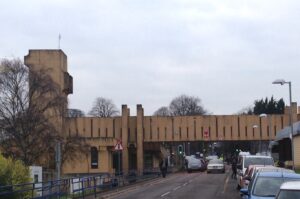
1960s: Transplantation
Above: Roy Calne (white coat) with dogs Tweedledee, Titus and Lollipop, recipient of the first successful long-term organ transplant, using azathioprine (Copyright of and with permission from Sir Roy Calne)
Attempts at transplantation (and there were many) were consistently unsuccessful before the 1960s. However a successful transplant had been achieved in Boston in 1954, between identical twins, confirming that the surgical approach was viable.
The 1960 Nobel prizewinner Peter Medawar, who identified that skin graft rejection was immunological, and described immune tolerance after in utero exposure, was pessimistic about the prospects for clinical transplantation because of his observations with skin grafts.
The UK’s first successful transplant, also between identical twins, was done in Edinburgh by Michael Woodruff in September 1960. The hospital superintendent reported “I think the recipient has a sporting chance of getting away with it”. He did, and died of cancer 6 years later.
Experiments in animals suggested that whole body irradiation could achieve immunosuppression. A second, brother-sister transplant in Edinburgh in 1961 led to death from sepsis after whole body radiation. This experience was repeated elsewhere, it seemed impossible to judge a dose that was immunosuppressive without fatal infection. However it continued as an adjunctive treatment in some centres for several years.
 When the first purpose-built transplant unit in the world opened in Edinburgh, it had a bridge to the radiotherapy department so that patients could be pre-treated and re-treated safely. Probably it wasn’t used by the time of its opening by Sir Peter Medawar in 1968. A common UK transplant unit design became a row of single rooms with positive pressure ventilation, and a glass corridor for relatives to wave to the recipients through the window. The Edinburgh unit was architecturally somewhat brutalist (RIBA), and informally termed ‘Fort Woodruff’.
When the first purpose-built transplant unit in the world opened in Edinburgh, it had a bridge to the radiotherapy department so that patients could be pre-treated and re-treated safely. Probably it wasn’t used by the time of its opening by Sir Peter Medawar in 1968. A common UK transplant unit design became a row of single rooms with positive pressure ventilation, and a glass corridor for relatives to wave to the recipients through the window. The Edinburgh unit was architecturally somewhat brutalist (RIBA), and informally termed ‘Fort Woodruff’.
From 1958 at the Royal Free Hospital in London, John Hopewell and Roy Calne were experimenting with mercaptopurine, the forerunner of azathioprine, and undertook their first attempted transplant in November 1959. Their first potential donor had died of a subarachnoid haemorrhage – they both recall their horror and disappointment at finding that their donor had the same kidney disease – polycystic kidneys – as the patient waiting for the transplant. A second donor’s kidney lasted only 3 days. However their third case, a live donor kidney recipient in November 1960 lived for 49 days, but was found at post mortem to have miliary tuberculosis.
Transplants had also been done in Leeds and St Mary’s hospital in the 1950s, without success.
Roy Calne joined the Department of Surgery in Boston under Francis Moore in 1960, and brought the use of azathioprine to Dr Murray’s lab and developed its subsequent use. A third transplant in Edinburgh in 1962 was the second transplant in the world using azathioprine, and it lasted for 20 years. (Early transplantation in Edinburgh).
At this point, the viability of long term dialysis was not at all clear. Transplantation was begun at Hammersmith, London, by Ralph Shackman in 1962, and at Westminster and then Cambridge by Roy Calne, back from Boston. However the results were extremely poor.
Kolff (the inventor of the first successful haemodialysis machine, now working in the USA) summarised the Cleveland Clinic’s figures and reported world experience to March 1964. Of 336 non-twin transplants, 102 were living – but only 14 had been alive more than one year, and 2 for more than 2 years.
From the UK, Parsons and Clark wrote to every transplant unit in Europe in 1965. They learned of 258 transplants and gained information on 187. Two kidneys came from chimpanzees, 100 from deceased donors and 89 from living donors. 22 (maybe 10%?) lived for more than 10 months. 37% of living donor kidneys failed in the first month; 63% of cadaveric. Only 5 of 48 recipients of failed grafts were kept alive by intermittent haemodialysis, the long-term use of which was still highly restricted.
But by this time long-term haemodialysis was beginning to look more competitive, albeit arduous and expensive. This was a surprise to some, as in several centres it had been introduced by surgeons mainly as a technique to keep patients alive until a transplant could be attempted.
It was only when the use of azathioprine in combination with prednisolone (steroid) for suppressing the immune system became better understood that the statistics began to improve perceptibly. For the period 1969-70, Calne, Shackman and Woodruff reported 59% 1-year survival from 131 cadaver allografts.
Further info
- John Hopewell’s detailed account of early UK transplantation
- Edinburgh unit early transplant history and its facilities
- Transplantation takes off in the mid-1960s (historyofnephrology blog)
- The first transplants: a last throw of the dice (historyofnephrology blog)
Authorship
Joyce Popoola. Early material based on the historyofnephrology blog by Neil Turner
Last Updated on May 25, 2023 by neilturn